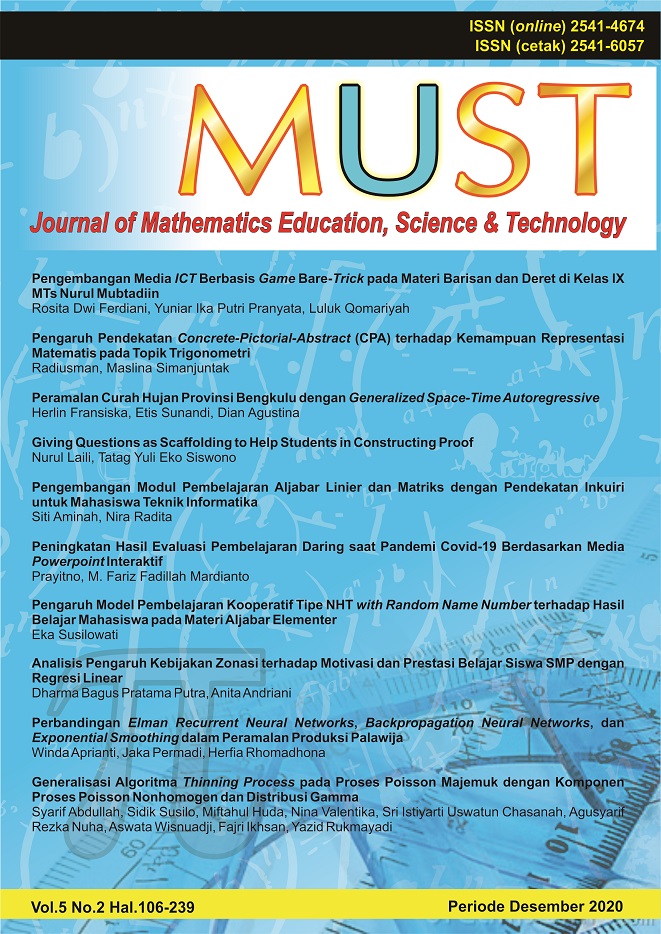Pengaruh Pendekatan Concrete-Pictorial-Abstract (CPA) terhadap Kemampuan Representasi Matematis pada Topik Trigonometri
Abstract
Full text article
References
Agrawal, J., & Morin, L. L. (2016). Evidence-based practices: applications of concrete representational abstract framework across math concepts for students with mathematics disabilities. Learning Disabilities Research and Practice, 31(1), 34–44. https://doi.org/10.1111/ldrp.12093
Astuti, E. P. (2017). Representasi matematis mahasiswa calon guru dalam menyelesaikan masalah matematika. Beta Jurnal Tadris Matematika, 10(1), 70. https://doi.org/10.20414/betajtm.v10i1.100
Batchelor, S., Keeble, S., & Gilmore, C. (2015). Magnitude representations and counting skills in preschool children. Mathematical Thinking and Learning, 17(2–3), 116–135. https://doi.org/10.1080/10986065.2015.1016811
Bouck, E., Park, J., & Nickell, B. (2017). Using the concrete-representational-abstract approach to support students with intellectual disability to solve change-making problems. Research in Developmental Disabilities, 60, 24–36. https://doi.org/10.1016/j.ridd.2016.11.006
Brijlall, D., & Niranjan, C. (2015). Using manipulatives to support an embodied approach to learning trigonometry in a south african school: a case study. Africa Education Review, 12(3), 361–380. https://doi.org/10.1080/18146627.2015.1110893
Dewolf, T., Van Dooren, W., & Verschaffel, L. (2017). Can visual aids in representational illustrations help pupils to solve mathematical word problems more realistically? European Journal of Psychology of Education, 32(3), 335–351. https://doi.org/10.1007/s10212-016-0308-7
Dündar, S. (2015). The relationships among pre-service mathematics teachers’ beliefs about mathematics, mathematics teaching, and use of technology in China. Eurasia Journal of Mathematics, Science and Technology Education, 11(6), 1363–1378. https://doi.org/10.12973/eurasia.2015.1396a
Gerhana, M. T. C., Mardiyana, M., & Pramudya, I. (2017). The Effectiveness of project based learning in trigonometry. Journal of Physics: Conference Series, 895(1), 0–6. https://doi.org/10.1088/1742-6596/895/1/012027
Gür, H. (2009). Trigonometry learning. New Horizons in Education, 57(1), 67–80.
Kalathil, R. R., & Sherin, M. G. (2000). Role of students’ representations in the mathematics classroom. Fourth International Conference of the Learning Sciences, 27–28.
Kamber, D., & Takaci, D. (2018). On problematic aspects in learning trigonometry. International Journal of Mathematical Education in Science and Technology, 49(2), 161–175. https://doi.org/10.1080/0020739X.2017.1357846
Mahayukti, G. A., Dianawati, N. P. S., Ardana, I. M., & Suryawan, I. P. P. (2019). The effect of concrete-pictorial-abstract learning strategy on spatial sense ability. Journal of Physics: Conference Series, 1317(1). https://doi.org/10.1088/1742-6596/1317/1/012007
Maor, E. (2013). Trigonometric delights. Princenton, New Jersey: Princeton University Press.
Mesa, V., & Herbst, P. (2011). Designing representations of trigonometry instruction to study the rationality of community college teaching. ZDM - International Journal on Mathematics Education, 43(1), 41–52. https://doi.org/10.1007/s11858-010-0300-7
Milton, J. H., Flores, M. M., Moore, A. J., Taylor, J. L. J., & Burton, M. E. (2018). Using the concrete – representational – abstract sequence to teach conceptual understanding of basic multiplication and division. Learning Disability Quarterly, 1–14. https://doi.org/10.1177/0731948718790089
NCTM. (2000). Principles Standards and Standards for School Mathematics. Reston: VA: National Council of Teachers of Mathematics.
Price, C., & Van Jaarsveld, P. (2017). Using open-response tasks to reveal the conceptual understanding of learners—learners teaching the teacher what they know about trigonometry. African Journal of Research in Mathematics, Science and Technology Education, 21(2), 159–175. https://doi.org/10.1080/18117295.2017.1329054
Putri, H. E. (2015). The influence of Concrete Pictorial Abstract (CPA) approach to the Mathematical representation ability achievement of the pre-service teachers at elementary school. International Journal of Education and Research, 3(6), 113–126.
Ramadhan, N. A. (2012). Penerapan pendekatan Concrete Pictorial Abstract (CPA) Bilangan cacah untuk meningkatkan hasil belajar matematika pada anak tunagrahita ringan kelas 6 di SD. Jassi Anakku, 11(2), 115–124.
Rosengrant, D., Etkina, E., & Van Heuvelen, A. (2007). An overview of recent research on multiple representations. AIP Conference Proceedings, 883, 149–152. https://doi.org/10.1063/1.2508714
Sahendra, A., Budiarto, M. T., & Fuad, Y. (2018). Students’ representation in mathematical word problem-solving: exploring students’ self-efficacy. Journal of Physics: Conference Series, 947(1), 1–5. https://doi.org/10.1088/1742-6596/947/1/012059
Salingay, N. R. R., & Tan, D. A. (2018). Concrete-pictorial-abstract approach on students’ attitude and performance in mathematics. International Journal of Scientific and Technology Research, 7(5), 90–111.
Sarkam, S., Sujadi, I., & Subanti, S. (2019). Mathematical connections ability in solving trigonometry problems based on logical-mathematical intelligence level. Journal of Physics: Conference Series, 1188(1). https://doi.org/10.1088/1742-6596/1188/1/012022
Solikin, A. (2016). Aplikasi aturan cosinus dan sinus segitiga bola dalam perhitungan arah kiblat (sebuah relasi antara matematika dan agama). MUST: Journal of Mathematics Education, Science and Technology, 1(2), 164. https://doi.org/10.30651/must.v1i2.235
Sousa, D. A. (2008). How the brain learns mathematics. Thousand Oaks, California: Corwin Press.
Varma, S., & Schwartz, D. L. (2011). The mental representation of integers: An abstract-to-concrete shift in the understanding of mathematical concepts. Cognition, 121(3), 363–385. https://doi.org/10.1016/j.cognition.2011.08.005
Wahyu, K., Amin, S. M., & Lukito, A. (2017). Motivation cards to support students’ understanding on fraction division. International Journal on Emerging Mathematics Education, 1(1), 99. https://doi.org/10.12928/ijeme.v1i1.5760
Walsh, R., Fitzmaurice, O., & O’Donoghue, J. (2017). What subject matter knowledge do second-level teachers need to know to teach trigonometry? An exploration and case study. Irish Educational Studies, 36(3), 273–306. https://doi.org/10.1080/03323315.2017.1327361
Whitin, P. E. (2007). The Mathematics Survey: A Tool for assessing attitudes and dispositions. Teaching Children Mathematics, 13(8), 426–433.
Authors
Authors who publish with this journal agree to the following terms:
- Authors retain copyright and grant the journal right of first publication with the work simultaneously licensed under a Creative Commons Attribution-NonCommercial 4.0 International License that allows others to share the work with an acknowledgment of the work's authorship and initial publication in this journal.
- Authors are able to enter into separate, additional contractual arrangements for the non-exclusive distribution of the journal's published version of the work (e.g., post it to an institutional repository or publish it in a book), with an acknowledgment of its initial publication in this journal.
- Authors are permitted and encouraged to post their work online (e.g., in institutional repositories or on their website) prior to and during the submission process, as it can lead to productive exchanges, as well as earlier and greater citation of published work

